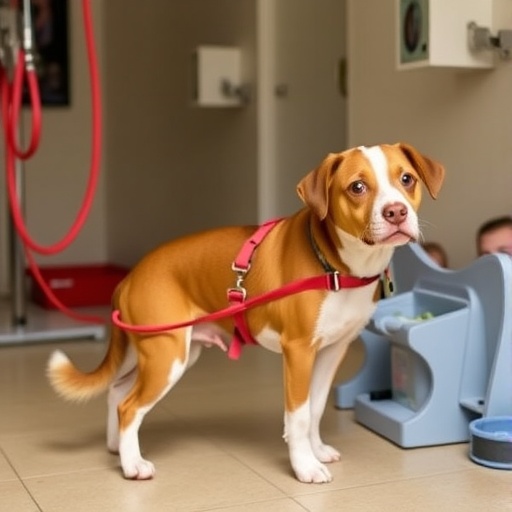A recent groundbreaking study has emerged, capturing the attention of both scientific communities and the general public alike. The research, conducted by a team led by Risberg, Larsson, and Bodén, delves into the fascinating connection between interaction with therapy dogs and physiological changes in children. The study focuses on urinary oxytocin levels, shedding light on how meeting a Hospital Dog® can elevate these levels in pediatric patients.
Oxytocin, often referred to as the “love hormone,” plays a critical role in social bonding, emotional regulation, and the development of trust among individuals. Its elevations are typically associated with feelings of happiness, affection, and social connection. The implications of this hormone extend beyond mere biology; they touch upon the very fabric of human relationships and emotional well-being. Previous research has established a link between interaction with animals and increased oxytocin release. However, this study specifically pinpoints the effects observed in children interacting with therapy dogs.
The participants of this study included a diverse group of children admitted to a hospital setting, an environment often fraught with anxiety and fear. In this high-stress atmosphere, the presence of a therapy dog provides a welcomed distraction and a source of comfort. The researchers meticulously measured the urinary oxytocin levels of these children before and after their interactions with the Hospital Dog®. The results were not only compelling; they offered tangible evidence of the therapeutic benefits that can result from such a simple act as petting a dog.
The methodology of the study was robust, employing a controlled environment to ensure the validity of findings. Each child was consented to participate in the study, and their baseline oxytocin levels were established prior to any interaction with the therapy dog. Immediate post-interaction samples were collected to accurately assess any fluctuations in hormone levels. This careful approach allowed the researchers to draw substantial conclusions regarding the role that these animals play in enhancing the well-being of pediatric patients.
The findings revealed a significant increase in urinary oxytocin levels in children after spending time with the therapy dog. This hormone spike underscores the physiological response triggered by the simple act of engaging with an animal. The presence of the dog appeared to facilitate not only emotional release but also neurological responses that enhance the feelings of safety and comfort within the hospital environment. The implications of these findings extend far beyond their immediate context; they may inform future practices in pediatric care and highlight the importance of integrating therapy animals into clinical settings.
Moreover, this research has the potential to influence hospital policies regarding patient care strategies. By showcasing the measurable benefits of therapy dogs, hospitals may be more inclined to adopt such practices, thereby improving the overall healthcare experience for children. The introduction of therapy dogs could represent a paradigm shift in how emotional health is viewed and managed in clinical contexts.
Further exploration into the relationship between therapy dogs and pediatric health is warranted, as the current study opens the door to numerous questions. Future research could investigate the long-term effects of therapy dog interactions on children’s psychological health, especially in relation to chronic conditions that necessitate frequent hospital visits. The implications of oxytocin beyond acute scenarios could provide crucial insights into childhood development and emotional resilience.
The study could also pave the way for broader discussions surrounding animal-assisted therapy. Hospitals are often microcosms of stress and tension, and incorporating therapy animals may enhance patient satisfaction significantly. When children feel more relaxed and at ease, their overall recovery processes could be expedited. This line of thinking aligns well with emerging trends in holistic approaches to healthcare, where emotional and psychological factors are increasingly recognized as vital components of patient recovery and well-being.
Anecdotal evidence from parents and caregivers has generally supported the notion that therapy dogs help to alleviate anxiety and improve the overall emotional landscape of children’s hospital experiences. The scientific underpinning provided by this research lends credence to those experiences and provides measurable data to back claims that therapy dogs have a therapeutic impact.
In summary, the study conducted by Risberg, Larsson, and Bodén underscores the profound influence that therapy dogs can have on children’s emotional and physiological states within a hospital environment. With clear evidence pointing towards elevated oxytocin levels following dog interactions, it becomes increasingly pertinent to explore how such interventions can be systematically integrated into healthcare practices.
As we move forward, the need for research focusing on the broader implications of these findings is undeniable. Could this lead to a shift in how clinical environments are structured to better accommodate emotional healing? This research could indeed be a stepping stone in a much larger movement towards compassionate care, where the emotional needs of patients are prioritized alongside their physical health.
Exploring the integration of therapy dogs into healthcare settings could create a new narrative around hospital visits for children. Rather than viewing these as experiences filled with fear and anxiety, there is a chance to transform them into opportunities for connection and emotional support.
The ripple effects of this study could influence not just one hospital but could inspire a wave of change across healthcare systems worldwide. Institutions might start to recognize the critical role of emotional well-being in patient outcomes, thereby funding and establishing programs centered around animal-assisted therapy.
Ultimately, research like this serves not just to fill gaps in our scientific understanding but also to illuminate possible pathways toward more compassionate and holistic approaches to healthcare. The therapeutic value of animals, especially in pediatric care, deserves continued examination, and this current study marks a pivotal moment in that exploration.
In conclusion, the significant find from this investigation into urinary oxytocin levels serves as a reminder of the interconnectedness of animals and humans. In an increasingly technological world, it is perhaps the simple, heartfelt connections brought by therapy dogs that can make the most meaningful impact on children’s health and happiness during challenging times.
Subject of Research:
The impact of therapy dogs on urinary oxytocin levels in children.
Article Title:
Urinary oxytocin levels in children meeting a Hospital Dog®.
Article References:
Risberg, A., Larsson, A., Bodén, U. et al. Urinary oxytocin levels in children meeting a Hospital Dog®. BMC Complement Med Ther 25, 327 (2025). https://doi.org/10.1186/s12906-025-05076-6
Image Credits:
AI Generated
DOI:
Keywords:
Urinary oxytocin, therapy dogs, pediatric care, emotional well-being, animal-assisted therapy.
Tags: benefits of animal-assisted therapychildren’s urinary oxytocin levelsemotional well-being in pediatric patientsenhancing trust and emotional regulationHospital Dog programimpact of therapy animals on stresslove hormone in childrenoxytocin and social bondingpediatric anxiety relief through animalsphysiological effects of therapy dogsresearch on therapy dogs in hospitalstherapy dog interactions





